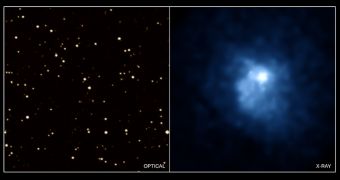A team of astronomers discovered amazing evidence of a brutal disruption in a huge galaxy cluster, a bright arc of ferociously hot gas that extends more than two million light years and must have been produced by one of the most energetic events ever detected.
Led by Ralph Kraft of the Harvard-Smithsonian Center for Astrophysics (CfA) in Cambridge, Massachusets, the astronomers took a picture of the giant cluster using NASA's Chandra X-ray Observatory.
They already knew that the galaxy named 3C438 in the central region of the cluster is known as an extremely energetic source of explosive activity, and they suspected a central supermassive black hole to be responsible for the massive outburst. But something doesn't fit in the picture: the energy in these outbursts is not nearly large enough to explain the Chandra data.
"The huge feature detected in the cluster, combined with the high temperature, points to an exceptionally dramatic event in the nearby Universe," said Kraft. "While we're not sure what caused it, we've narrowed it down to a couple of exciting possibilities."
At 170 million degrees Celsius, the gas filling the galaxy cluster is not just hot, it's also supercondensed, with an estimated mass of a quadrillion, or 1,000 trillion, suns, truly making the cluster the titan of titans.
One of the possible explanations would be a massive collision between two large galaxies, that is still going on at about 4 million miles per hour. This extremely violent encounter between the gaseous masses of the two galaxies could generate shock waves through a sharp change in pressure along the boundary where the collision is occurring, giving rise to the observed arc-shaped structure which resembles a titanic weather front.
"Although this would be an extreme collision, one of the most powerful ever seen, we think this may be what is going on," said team member Martin Hardcastle, of the University of Hertfordshire, United Kingdom.
Another explanation would be the infall of matter into a supermassive black hole located in a central galaxy, events previously known to occur in the deep space.
"If this event was an outburst from a supermassive black hole, then it's by far the most powerful one ever seen," said team member Bill Forman, also of CfA.

 14 DAY TRIAL //
14 DAY TRIAL //